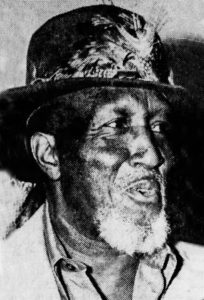
(Aug. 27, 1931-Mar. 18, 1997). Charles (Snookie) Hendricks was born and raised in Indianapolis. He lived in and attended . He joined the Army when he was 17 where he claimed, “an Army hospital screw-up in 1948 hooked him on heroin,” an addiction that would stymie his community activism throughout his life. As the city’s most visible African American activist in the 1960s, Hendricks led sit-ins outside Governor Edgar Whitcomb’s office, had his share of brushes with the law, and worked for Mayor as a liaison to the Black community.
With like-minded activists in his neighborhood, Hendricks established and headed the first Black militant organization in Indianapolis, the Black Radical Action Project (BRAP), incorporated on August 16, 1968. The organization served as an incubator for political participation among the African American community. With Hendricks at its helm, the group protested myriad causes affecting the Black community, including anti-Vietnam-War and prison reform demonstrations. , later a longtime state representative from Indianapolis, joined the yet-to-be incorporated group in April 1968.
Hendricks and fellow Black activist Ben Bell worked with Richard Lugar after he won the Indianapolis mayoral race in 1968. The two activists persuaded the Black community to support the mayor’s initiatives to break down racial inequality in Indianapolis and helped to maintain peaceful relations between the Black community and the local government.
Lugar credited Hendricks and the BRAP with maintaining peace in Indianapolis in the wake of the assassination of Dr. Martin Luther King Jr. on April 4, 1968. Robert Kennedy delivered news of King’s slaying to a crowd of mostly Black citizens who had gathered to hear his presidential campaign speech that very day. Hendricks worked to maintain calm among the crowd not only during the but in the days afterward. Indianapolis did not experience the hostility that erupted in the wake of King’s assassination as many parts of the United States did.
In 1973, Lugar helped Hendricks acquire a job as a neighborhood coordinator with the City-County Council-funded Community Service Project. Hendricks was suspended without pay on October 23, 1973, following a federal indictment charging him with possession of heroin and a firearm when police stopped a car in which he was a passenger on August 29, 1973. At the time of his arrest, Hendricks was also awaiting trial on federal charges of perjury, bribery, and conspiracy growing out of an alleged attempt to bribe a government witness in a federal drug case. Hendricks resigned his position with the Community Service Project while awaiting trial.
In return for a guilty plea to the gun and drug violations federal Judge dropped the charges of perjury, bribery, and witness intimidation on December 17, 1973. Hendricks received a 2-year suspended sentence and 2 years’ probation rather than the maximum 10-year prison sentence and $10,000 fine. But his problems with the law did not end there. In November 1975, Steckler sent Hendricks to the Indiana Federal Prison Camp (U.S. Penitentiary) at Terre Haute, Indiana, for violation of the 1973 probation. He was released during the summer of 1977. Hendricks was arrested on a federal charge of possession of heroin with intent to distribute on August 18, 1978. Exactly three months later, he was re-arrested in connection with the August incident and sentenced to 3 years minus 84 days (time already served in jail) in prison after pleading guilty to interstate travel with the intent to buy heroin on February 9, 1979. Hendricks was paroled a year later.
By June 1982, Hendricks worked as chairman of the Prison Reform Committee of Indianapolis for the NAACP. He later formed Indiana’s first branch among inmates at the federal penitentiary where he served time. In the 1990s, Hendricks worked with the NAACP during its Police Community Relations Hearings. A panel of NAACP investigators and the Harvard University Criminal Justice Center studied police conduct in Indianapolis and six other cities to develop a national report of police violence based on the hearings.
To honor the many forms of Hendricks’ activism, the awarded Hendricks with its Lest We Forget Award on December 19, 1993. The award recognizes those in the community who have made a difference in their pursuit for equality for all people.
In his personal life, Hendricks fathered 26 children by more than 14 women. He overcame the heroin habit he picked up in the armed forces by converting to Islam. After converting to Islam Hendricks also used the name Hassan Abdul Hakeem.
After berating drug dealers for pedaling narcotics in the neighborhood, Hendricks was shot in the back and killed outside his home in the 4000 block of Boulevard Place. He was 66 years old.

Help improve this entry
Contribute information, offer corrections, suggest images.
You can also recommend new entries related to this topic.